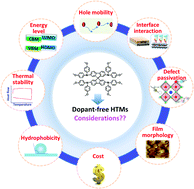Design of dopant-free small molecular hole transport materials for perovskite solar cells: a viewpoint from defect passivation
Abstract
The overwhelming improvement in performance and the cost-effective solution processing enable perovskite solar cells (PVSCs) as a promising technology in the photovoltaic industry. Doped hole transport material (HTM)-based high-efficient PVSCs are facing challenges from device cost, stability, and scale-up fabrication. The development of highly-efficient dopant-free HTMs evolves as an effective approach to realize high-performance and stable PVSCs. In this review, we update herein the recent advances in the molecular design of undoped HTMs from the viewpoint of perovskite defects passivation and enhancing the PVSCs performance. Rational design strategies are proposed on the basis of constructing the interfacial interactions with perovskite layers. Taking successful HTMs as examples, we elaborate the design principles of dopant-free HTMs for highly-efficient and stable PVSCs. The correlation study between molecular structures and device performance and long-term stability of PVSCs is presented. Finally, a perspective on the development of dopant-free small organic HTMs is given for efficient and stable PVSCs toward their commercialization.



 Please wait while we load your content...
Please wait while we load your content...